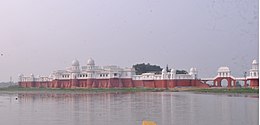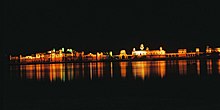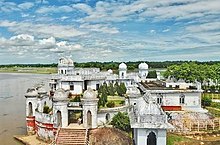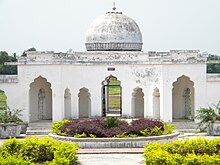
Agartala is the capital and the largest city of the Indian state of Tripura, situated on the banks of Haora/Saidra River, about 2 kilometres (1.2 mi) east of the border with Bangladesh and about 2,499 km (1,552 mi) from the national capital, New Delhi. According to 2022 AMC data, Agartala is the third most populous city after Guwahati and Imphal in Northeast India. It is India's third international internet gateway and being developed under the Smart Cities Mission.

Maharaja Bir Bikram Airport, also known as Agartala Airport, is an international airport situated 12 kilometres northwest of Agartala, the capital of Tripura. It is administered by the Airports Authority of India (AAI). It is the second busiest airport in North-East India after Lokpriya Gopinath Bordoloi Airport in Guwahati and 29th busiest airport in India. It is the third international airport in North-East India, after Lokpriya Gopinath Bordoloi Airport and Imphal Airport.

The State of Tripura, in northeastern India, has a long history. The Twipra Kingdom at its peak included the whole eastern region of Bengal from the Brahmaputra River in the north and west, the Bay of Bengal in the south and Burma to the east during the 14th and 15th centuries AD.

The Tripuri are a Tibeto-Burman-speaking ethnic group of Northeast Indian state of Tripura. They are the descendants of the inhabitants of the Twipra/Tripura Kingdom in North-East India and Bangladesh. The Tripuri people through the Manikya dynasty ruled the Kingdom of Tripura for ~450 years until the kingdom joined the Indian Union on 15 October 1949.
The Pushbanta Palace also known as Kunjaban Palace is one of former royal palace of Tripura, it was built by Maharaja Birendra Kishore Manikya in 1917. It was the Raj Bhavan of Tripura till 2018, which later shifted. The palace is being developed as a national-level cultural museum.
The Twipra Kingdom was one of the largest historical kingdoms of the Tripuri people in Northeast India.

The Manikya dynasty was the ruling house of the Twipra Kingdom and later the princely Tripura State, what is now the Indian state of Tripura. Ruling since the early 15th century, the dynasty at its height controlled a large swathe of the north-east of the Indian subcontinent. After coming under British influence, in 1761 they transitioned from feudal monarchs into rulers of a princely state, though the Manikyas maintain control of the region until 1949, when it ascended in union with India.
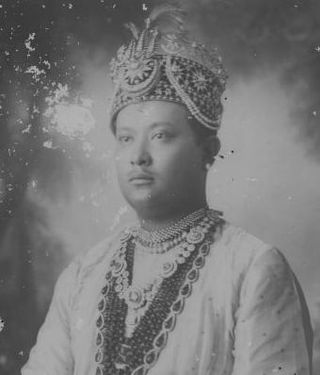
Maharaja Bir Bikram Kishore Manikya Debbarma Bahadur was a king of Tripura State.

Pradyot Manikya Deb Barma is the current titular King (Maharaja) and statesman from Tripura. He was born in New Delhi, and now resides in Agartala, Tripura. He also served as the editor of TNT-The Northeast Today. He is the current chairman of The Indigenous Progressive Regional Alliance also known as TIPRA Motha. He is known as 'Bubagra' among his people and is one of the active voices for the rights of Indigenous Tripuri people of Tripura.

Ujjayanta Palace is the state museum of the Indian state of Tripura and former royal palace of the princely state of Tripura. It was built by Maharaja Radha Kishore Manikya in 1901. It housed the State Legislative Assembly up to 2011. The palace primarily showcases the lifestyle, arts, culture, tradition and crafts of communities residing in northeast India, along with many stone sculptures of the Manikya dynasty.
Tripuri Kshatriya is a Vaishnav caste group which encompasses almost all the members of the Tripuri, Reang, Jamatia and Noatia ethnic groups, most of whom live in the Indian state of Tripura. The Tripuri Royal Family belonged to the Tripuri ethnic group, from the Debbarma clan. Originally the term "Tripur Kshatriya" was used to denote the Tripuri ethnic group only, but in due time, the Maharajah included the remaining three ethnic groups as well, in an attempt to foster a sense of kinship among his people. With the influx of the Bengali immigrants from neighboring places, the Tripuris lost their majority in their own kingdom and the Maharajah's power was taken away by the Indian government. Formerly, the community was organized under the Tripura Kshatriya Samaj, which was headed by the Maharajah of Tripura himself.
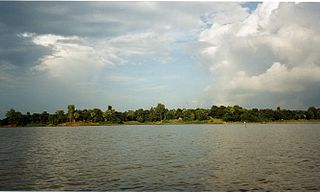
Rudrasagar Lake, also known as Twijilikma, is a lake located in Melaghar, Tripura, India.

Maharani Kanchan Prava Devi was a Queen of Tripura as the wife of Bir Bikram Kishore Debbarma, King of Tripura State. After her husband's death in 1947, she was regent of Tripura until it was merged with India in 1949.

Bijoy Sagar is a lake in Udaipur in North-East India. It is also called Mahadeb Dighi. It is one of the largest lakes in Udaipur in Tripura. The lake is 750 feet in length and 450 feet in breadth. The area around the lake is densely settled. The lake is contaminated with domestic sewage and waste water through one drain located on the north-eastern side. The population depends on Bijoy Sagar for bathing, washing, fishery etc. Also solid waste by the surrounding households area also vacated into the Mahadev Dighi. It is also alternatively spelt as Bejoy Sagar.

Tripura State, also known as Hill Tipperah, was a princely state in India during the period of the British Raj and for some two years after the departure of the British. Its rulers belonged to the Manikya dynasty and until August 1947 the state was in a subsidiary alliance, from which it was released by the Indian Independence Act 1947. The state acceded to the newly independent Indian Union on 13 August 1947, and subsequently merged into the Indian Union in October 1949.

Melaghar is a small town located in the Indian state of Tripura and a Municipal Council in Sipahijala district, situated about 50 km from the capital Agartala. It is a neighbour to Sonamura and 10 km away from the Bangladesh International border. Neermahal is a famous tourist attraction in the town, situated in the middle of Rudrasagar Lake.
Maharaja Kirit Bikram Kishore Manikya DebBarma Bahadur was the 185th and last King of Tripura, a princely state in northeastern India. His formal coronation was held in 1941, but he never gained the powers of a king.

Kokborok Cinema refers to the Kokborok language film industry in Tripura, India and among the Tripuri people. Tripura's Kokborok film industry began in 1986 with Longtharai (1986) directed by Dipak Bhattacharya adapted from Bimal Sinha's novel Karachi theke Longtharai depicting the struggle-ridden life of jhum cultivators in the rural hills of Longtharai followed by the Kokborok film Langmani Haduk (1993) directed by Ruhi Debbarma can be read as a critique of the modern regime. The Kokborok film Mathia (2004) directed by Joseph Pulinthanath, is the first International Award-winning Kokborok film.

Tripura is a state in the North-East India and the third smallest state in India. Tripura is widely regarded as a beautiful destination, appreciated for its picturesque landscape and delightful climate. The tourism in Tripura is maintained by TTDCL, a state government owned enterprise.



